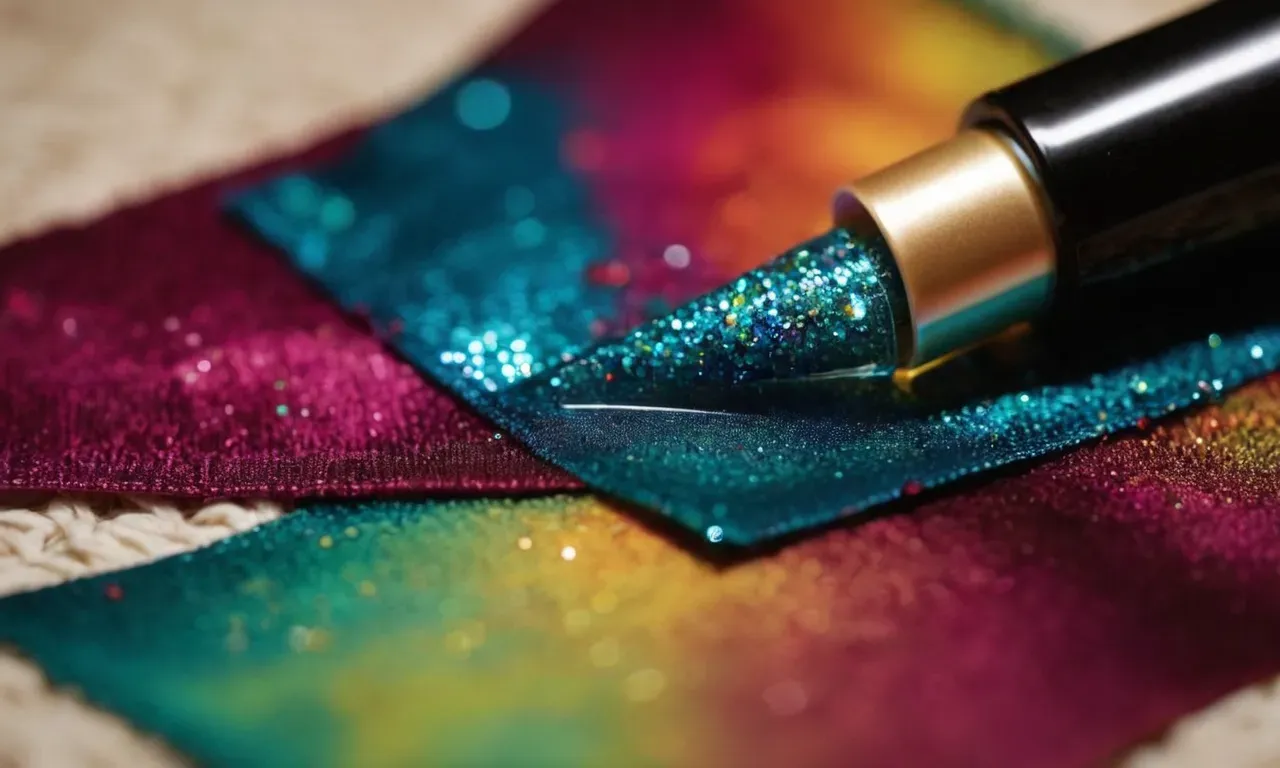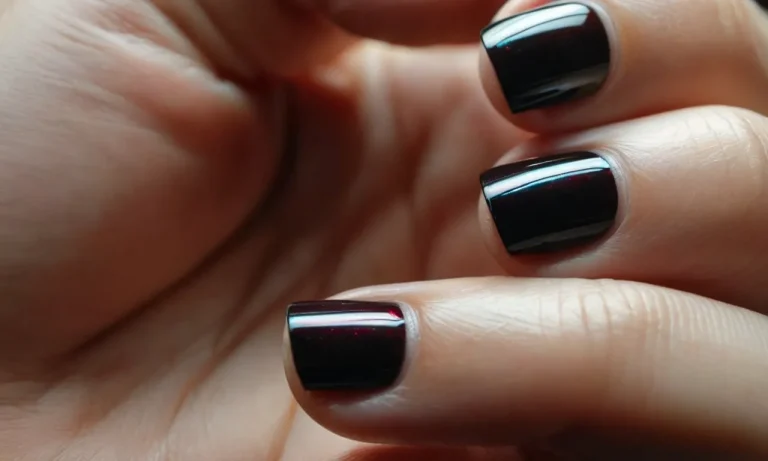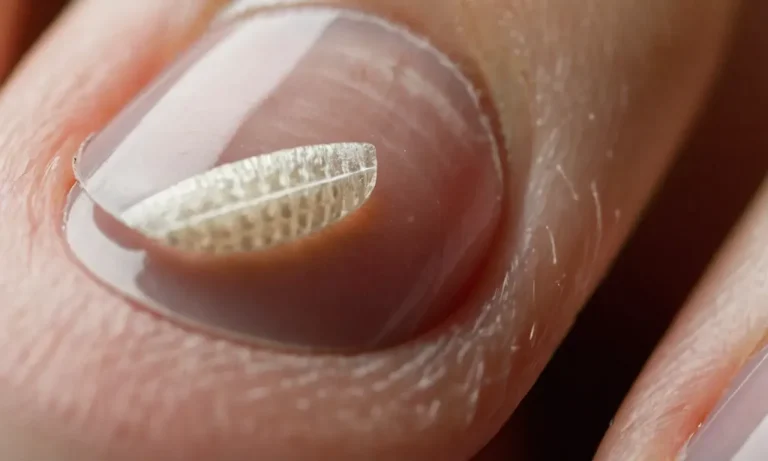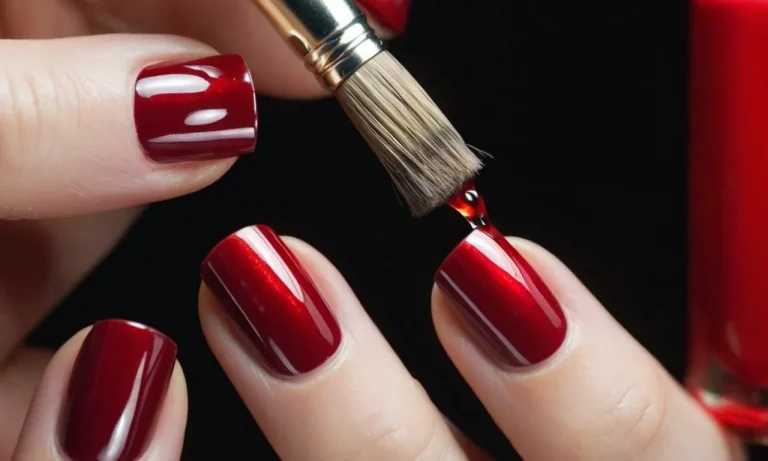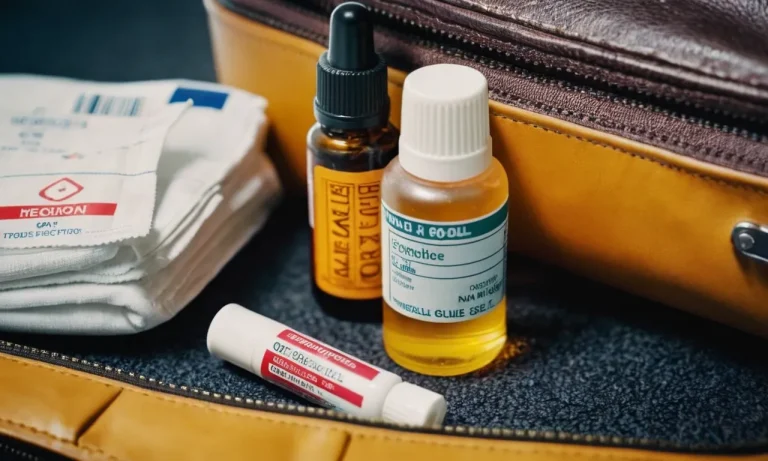How To Get Gel Nail Polish Out Of Clothes: A Comprehensive Guide
Nail polish stains on your favorite shirt or pair of pants can be annoying and seem impossible to remove. But don’t panic – removing gel nail polish from clothing is possible if you act quickly and use the right techniques.
If you’re short on time, here’s a quick answer to your question: Gently scrape off any excess polish with a dull knife or credit card, then apply nail polish remover to the stain and let it sit for 5-10 minutes before scrubbing and rinsing.
Rubbing alcohol, hairspray or vinegar can also help break down the polish.
In this comprehensive guide, we’ll go over everything you need to know about getting stubborn gel nail polish out of clothes and fabrics. You’ll learn about different stain removal methods, how to test for colorfastness, the best products to use, and step-by-step instructions for treating different types of fabric.
Understanding Gel Nail Polish
What makes it different from regular nail polish
Gel nail polish has a unique chemical formulation that sets it apart from traditional lacquers. When cured under a UV or LED lamp, gel polishes form durable, hardened layers on nails through a process called photoinitiation.
This makes the manicure extremely stiff, long-lasting and chip-resistant compared to regular polish that simply dries and can chip within days.
While regular lacquers contain nitrocellulose, plasticizers and solvents, gel polishes use methacrylate monomers as the main ingredient. When exposed to the lamp, photoinitiators in the formula react, causing the monomers to link together into tough, cross-linked chains of polymers that adhere well to the nail plate.
This flexible polymeric film is what gives gel manicures their resilience and allows them to last up to 3 weeks with minimal flaws.
Additionally, the viscosity of gel polish tends to be thicker than classic nail enamel. This consistency helps it self-level better on the nail for smooth application without running into cuticles or tips.
The opacity is also greater with gels, providing them with superior hiding power to produce flawless, vibrant color that resists fading over time.
Why it stains fabric and is hard to remove
When gel manicures begin chipping or lifting off the nails, they can get caught on clothing and other materials, leaving behind stubborn residue. Compared to regular polish that would just flake off, the durable acrylic film formed by cured gel adhesive clings to fabric.
Moreover, gel residue contains polymers that can permanently bind to fibers. Attempting removal once dried proves extremely difficult since the cross-linking makes the formula insoluble in typical cleaning solutions. The tenacious bonds resist breaking down, allowing splotches to set into material.
Excess wet gel polish that gets on clothes undergoes photoinitiation under ambient light or sunlight. As monomers transform into hardened plastic, they fuse to textile, forming lasting stains. This photochemical curing also occurs on fingernails if the liquid seeps out the cuticle to induce corresponding discoloration known as “gel stain”.
Furthermore, dark gel shades like blues, greens and purples contain high levels of pigment particles that drive staining. The pigments efficiently absorb into threads because of their tiny size. Prolonged contact escalates dye transfer, with colors permanently settling into fabric.
Checking Clothes for Colorfastness
Why this is an important first step
Before attempting to treat a gel nail polish stain on clothing, it is crucial to test if the fabric is colorfast. Colorfastness refers to how well the original fabric color holds up when exposed to cleaning solutions or products like stain removers.
If the fabric is not colorfast, trying to remove the stain can actually make the situation worse by causing the original fabric dye to bleed, spread, or fade.
Testing for colorfastness only takes a minute. It involves applying a small amount of the planned stain removal solution to an inconspicuous area of the garment, letting it sit briefly, then blotting and checking if any color has transferred.
This simple step saves your clothing from potential damage and allows you to determine if the planned stain treatment is safe to use.
How to do a colorfastness test before treating the stain
Follow this quick process to check if your garment is colorfast before trying to remove a gel nail polish stain:
- Select an interior seam or hem area on the back or inside part of the garment. This prevents any fabric dye loss from being visible.
- Use an eyedropper to apply a few drops of the stain remover solution you plan to use. Possible options are rubbing alcohol, nail polish remover, or cleaning solvents.
- Let the solution sit on the fabric for 2-3 minutes. Do not rub it.
- Blot the area gently with a clean white paper towel or cloth. Check if any color has transferred onto the towel.
- If no dye has bled or faded, then proceed to treat the stain. If color loss occurred, do not use that solution as it may damage the clothing.
Being aware of your fabric’s colorfastness protects your garments from unnecessary damage. Minor color fading or transfer in an inconspicuous location is normal, but significant color loss means the planned stain treatment is too harsh for the clothing type and needs adjustment.
Taking a bit of time for this test saves you from permanently damaging your clothing in the process of stain removal.
Treating Gel Polish Stains on Washable Fabrics
Steps for cotton, polyester and other machine washable fabrics
Removing gel polish stains from cotton, polyester, and other machine washable fabrics like linens or towels can be done with some tried and true techniques. Here are the steps to follow:
- Blot the stain immediately. Don’t rub it, as that can push the stain further into the fabric.
- Apply a non-acetone nail polish remover or rubbing alcohol directly to the stain. Let it sit for a few minutes to break down the nail polish.
- If needed, use an old toothbrush or other soft bristle brush to gently work the remover into the fabric. This helps break up the nail polish.
- Rinse the fabric under cold running water until the remover is washed away.
- Launder as usual, checking to see if the stain is gone once dry.
- For tough stains, repeat the process before washing.
Using nail polish remover or alcohol to break down the stain
The key product for removing gel polish from clothing is a nail polish remover, preferably one without acetone. Acetone can damage and discolor some fabrics. A non-acetone nail polish remover contains milder ingredients like ethyl acetate to break down the nail gel. Rubbing alcohol works too.
Check for colorfastness first on an inside seam, then apply a small amount directly to the stain. Let it sit for 2-3 minutes before dabbing at the spot and rinsing. This breaks down the nail polish so it can come out in the wash.
Trying other DIY stain removers like vinegar or hairspray
For delicate fabrics, try a homemade stain remover before resorting to harsher chemicals. Two DIY options are:
- Vinegar: The acetic acid in plain white vinegar can dissolve nail polish stains. Mix 1 part vinegar with 1 part water and apply to the stain. Let sit 1-2 minutes before dabbing the spot with a clean cloth and rinsing.
- Hairspray: The alcohol in hairspray can also break down polish. Spray liberally over the stain and let sit a few minutes before rinsing.
Test colored vinegar or hairspray on a seam first since they can cause discoloration. But they are effective options for tough gel polish spills on delicate fabrics.
Laundering after treatment
After applying a stain remover and rinsing, it’s time to launder the fabric. Wash and dry as usual. If any hint of the stain remains, don’t put the item in the dryer yet. Repeat the stain removal process and wash again.
Here are some handy laundry tips for getting gel polish out:
- Use the warmest water recommended for the fabric.
- Add an enzyme presoak or booster to help remove traces of the polish.
- Make sure to fully rinse out any removers or cleaners.
- Air dry first to check if the stain is gone before drying.
- Dry on low heat; high heat can set any remnants of the stain.
With the right stain removal methods and laundry techniques, even dried gel polish stains can be conquered. Just take it step-by-step to protect your clothes and linens.
Removing Stains from Delicate Fabrics
Special care for silks, wools and other delicates
When dealing with gel nail polish stains on delicate fabrics like silk, wool, viscose, or cashmere, extra care must be taken to avoid damaging the material. These fabrics are more prone to shrinkage, distortion and color loss when exposed to heat, agitation, and harsh chemicals.
Start by blotting the stain with a clean white cloth or paper towels to absorb as much of the polish as possible. Avoid rubbing, which can grind the stain further into the fibers.
Before treating the stain, test any solution you plan to use on an inconspicuous area of the garment, like an inside seam. Check for colorfastness and fabric damage.
Using a stain pretreatment product
For lightweight stains on delicates, a specialized stain pretreatment product for delicates may be effective. Choose one that is free of bleaches or optical brighteners that could damage dyes. Popular options include Woolite Delicates, Carbona Stain Devils #10, or Persil Delicates.
Follow the product directions closely. These pretreatments often work best if applied directly to the stain, allowed to sit for 5-10 minutes, and then laundered as usual in cold water. The active enzymes break down stubborn stains over time.
Handwashing and air drying
For heavier stains, the most effective method is to handwash the garment in a mild detergent solution. Mix a small amount of gentle laundry detergent, like Woolite or baby shampoo, in a basin of lukewarm water.
Allow the garment to soak in this solution for at least 30 minutes, occasionally agitating the stain by dabbing it with a soft toothbrush.
Rinse thoroughly in clean water to remove all soap residue which can attract dirt over time. Do not wring or twist the garment, which can stress the fibers. Instead, gently press out excess moisture using rolled up towels.
Lay the garment flat on top of another dry towel or breathable mesh bag, reshape as needed, and allow to thoroughly air dry. Avoid direct heat sources like radiators or sunlight, which could set in any remaining stains.
For badly stained or damaged areas, consider consulting a professional fabric restoration specialist. They have access to techniques like ozone treatment and can patch damaged portions.
Dealing with Stubborn Gel Stains
Repeated applications of nail polish remover
Gel nail polish is designed to be super stubborn and long-lasting on nails. Unfortunately, this also means it can leave behind stubborn stains if it gets on clothing or other fabrics. Repeatedly applying nail polish remover is often the first line of defense against these tricky stains.
Start by blotting the stain with a paper towel or clean cloth. Then, apply a small amount of pure acetone nail polish remover directly to the stain. Let it sit for 5-10 minutes so it can penetrate the fibers and break down the nail polish.
Blot the area again and check if the stain has lightened or come out. If not, repeat the process, letting the remover sit longer each time. The key is patience here – you may need to apply it multiple times over 30+ minutes for it to fully dissolve the polish.
One tip is to place an absorbent material under the fabric as you hold it taut. This will help draw the polish up and out of the fibers. Be persistent and keep reapplying new remover as it evaporates. With some effort, this method can conquer even set-in gel stains.
Considering bleach for white fabrics
If repeated solvent applications aren’t cutting it, try an oxygen bleach product on white or colorfast washable fabrics. Test first on an inconspicuous area to ensure colors won’t be affected. Then mix up a solution of 1 part bleach to 4 parts cold water and submerge the stained part of the garment.
Let it soak for at least 8 hours or even overnight, checking periodically. This allows time for the bleach to break the stubborn polish bonds. When ready, rinse thoroughly and launder as usual with detergent and oxygen bleach if desired.
This method can be surprisingly effective at removing dried gel polish from places acetone alone can’t touch.
Some good oxygen bleach product options are OxiClean Versatile Stain Remover, Clorox 2, or Vanish White Rescue Laundry Whitener + Brightener. Always follow safety precautions when using bleaches.
When to take clothes to the dry cleaner
If you’ve tried all home remedies with no success, consider taking items to a professional dry cleaning service. Dry cleaners have access to specialized solvents and techniques that can tackle severe gel manicure stains without damaging fabrics.
In particular, they often rely on perc (short for perchloroethylene) – a heavy-duty cleaner great for removing embedded oil-based products like nail polish. Along with stronger solvents, dry cleaners also have commercial machines that can flush solutions fully through fabric fibers to extract stains.
The cost is higher than home methods but may be worth it for expensive or special garments. As soon as you notice a fresh stain, bag the item to prevent setting and bring to the cleaners. Don’t launder first or apply any other chemicals.
With the right methods, dry cleaning stands the best chance of rescuing clothes from gel manicure mishaps.
Conclusion
While gel nail polish stains can be difficult to conquer, it is possible to get them out of clothing and fabrics. With some persistence and the right stain removal products and techniques, you can salvage your garment. Always check for colorfastness first, and never put stained clothes in the dryer.
With a bit of elbow grease, your clothes can look good as new again. Now you have all the tools you need to effectively treat gel nail polish stains on any type of fabric.

